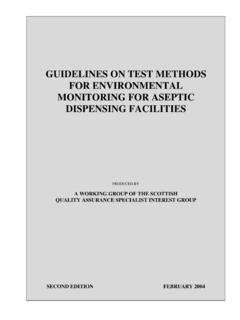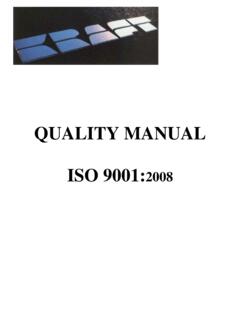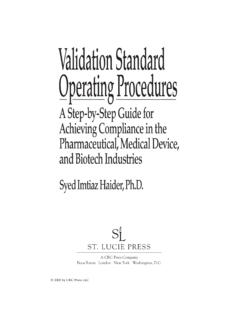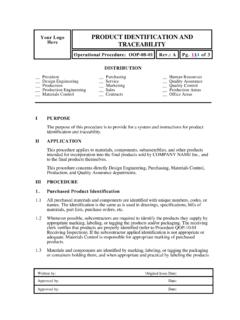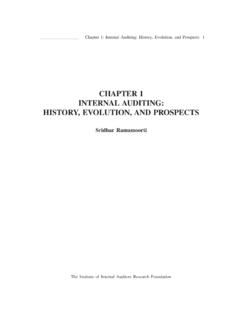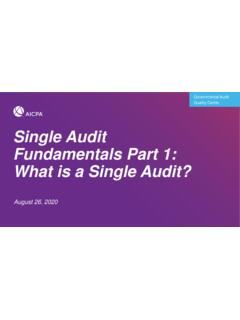Transcription of The Audit Process Manual - elsmar.com
1 THEAUDITPROCESSD epartment of Health & Human ServicesOffice of Inspector GeneralOffice of Audit ServicesFOREWORDThis handbook has been developed to give auditors tools to conductaudits and prepare reports. It lays out a systematic approach designed tokeep the Audit focused, involve all team members throughout the processand facilitate report preparation. Auditors must have a clearunderstanding of what they are supposed to be doing and how toaccomplish the task at hand. At the same time, auditors should beencouraged to develop innovative Audit approaches and use theirexperience and background to identify new Audit initiatives. Users ofthis handbook should be familiar with the Government AuditingStandards and the Office of Audit Services Audit Policies andProcedures Manual . These provide the guidance that assures aprofessional approach to conducting audits described in this handbook is basedon three principles: Teamwork is more efficient and effective than a layered,hierarchical system of getting audits done.
2 Setting clear, specific objectives for an Audit before thefield work starts and having the flexibility to refocus andrefine the objectives during the Audit will provide thedirection for the work to stay on track. The five attributes should be the focus of the Audit team inaccomplishing the Audit objectives. This handbook stresses teamwork and introduces the ObjectiveAttributes Recap Sheet (OARS). The OARS is a worksheet that isintended to help the Audit team establish objectives, stay focused on theobjectives and develop the attributes for the understand the participation of team members and the use of theOARS, we have defined an Audit as having six phases. Throughout theaudit it is expected that all members of the Audit team will be continuallyinteracting with each other. On-site auditors, including senior auditors,will review and discuss each other s work; Audit managers, RegionalInspectors General for Audit Services, and Assistant Inspectors Generalfor Audit Services will participate in decision making during each phaseof the Audit .
3 On reviews for the Inspector General s signature, theDeputy Inspector General for Audit Services, General Counsel and AuditPolicy and Oversight staff will also participate at critical points in theprocess. Where a team member is unable to participate during a portion of theaudit, it will be understood that the other team members will carry onand that the progress of the Audit will not be delayed. Ideally, teammembers will function together through all six phases of the Audit andthe OARS will serve as the tool that will keep the team and the auditfocused. Realistically, team members will have a number of prioritiesdemanding their attention. Working with clearly established objectivesand using the structure of the attributes should help team members beresponsive to their priorities. To accomplish this, it is essential that theteam members agree on the Audit objectives and finding attributes duringthe preliminary planning phase, at the end of the survey phase and at thestart of the reporting phase.
4 Our mission is to provide a variety of Audit services to a variety ofcustomers and this service takes the form of performing audits andreporting on the results. We believe that the Office of Audit Services(OAS) can best provide this service through a systematic approach toauditing based on team participation, clear objectives for eachassignment and focusing the Audit work on development of the attributesof an Audit finding. Although these principles apply to all auditsperformed by OAS, we recognize that financial statement auditsperformed under the Chief Financial Officers (CFO) Act of 1990 wouldnot come under the guidelines of this handbook. Financial statement audits performed in accordance with the CFO Actare conducted following the Federal Financial Statement Audit Manualissued by the President s Council on Integrity and Efficiency. Thismanual has its own proforma working papers and the primary focus ofthe Audit is on risk analysis and on determining whether agencyoperations are accurately reflected in the financial statements.
5 Auditresults may affect the Audit opinion, the report on internal controls orcompliance, etc., but may not necessarily include the attributes normallyexpected in Audit findings. The handbook has three parts:PART 1: Audit Teams, Objecti ves, Attri butes and Phases of theAu di t Pr oc e ss - Discusses the three principles of systematicauditing: teamwork, clear objectives and attributes of afinding, in the context of the six phases of an Audit . This partalso introduces the primary tool that runs through the Audit ,the OARS. The OARS is a worksheet that is intended to beused in each phase of the Audit . The OARS should serve as atool for organizing thoughts, an aid for staying focused on theobjectives of the Audit , an outline for findings, a focal pointfor discussion among team members on the progress of thework, and an aid for the independent report review 2: Audit Evi dence and Working Papers - Assures that theaudit is performed in compliance with the GovernmentAuditing Standards and the OAS Audit Policies andProcedures Manual and provides guidance on documentingthe Audit .
6 PART 3: Standard Working Paper Forms - A compendium ofstandard working paper (SWP) forms for documenting auditwork as required by Government Auditing Standards andthe OAS Audit Policies and Procedures Manual . Theseforms are optional, unless required by agency policy. Theyare provided as an aid for the auditor to meet thedocumentation requirements of the standards. All of theseforms are available in WordPerfect format. This handbook was prepared by a committee whose members haveextensive experience in the auditing profession and in the Department ofHealth and Human Services (HHS). The committee took a fresh look athow we have been doing our audits and the characteristics of some of themore successful audits. The Process of preparing the handbook was agroup effort that resulted in a product intended for use by those at alllevels of involvement in our audits. The committee members are:Donald L. Dille, Region VI (Chair)Craig T. Briggs, Health Care Financing AuditsJames P.
7 Edert, Region IIRobert F. Fisher, Human and Financial ResourcesJames R. Hargrove, Region VIHelen M. James, Audit Policy and OversightThomas E. Justice, Region IVDavid J. Kromenaker, Region VThomas P. Lenahan, Region IXJohn W. Little, Region VIThe committee was ably assisted by Dana Duncan of the Region IV ATSstaff. Mr. Duncan developed a menu-driven package of automatedworking papers with all of the bells and whistles that even the novicecomputer user will find easy to Wayne Knoll deserves special recognition. Dr. Knoll provided theinitial thought that development of the Audit report is, in fact, the processof the Audit . The committee, with Dr. Knoll s active participation,incorporated and expanded on that concept in this handbook. The resultis this comprehensive discussion of the Audit Process . Throughout thework of the committee, Dr. Knoll s insight, suggestions and support wereinvaluable. In addition, I would like to acknowledge the assistance that thecommittee received from Ms.
8 Martha Heath of the Region VI desktoppublishing staff. Ms. Heath s creativity and innovativeness are veryevident in the professional appearance of this product. Thomas D. Roslewicz Deputy Inspector General for Audit ServicesPART 1 - Audit TEAMS, OBJECTIVES, ATTRIBUTES AND PHASES OF THE Audit PROCESSAUDIT TEAMS .. 1-1 Quality Communication .. 1-1 Team Meetings .. 1-2 OBJECTIVES .. 1-3 ATTRIBUTES OF AN Audit FINDING .. 1-5 Criteria .. 1-6 Condition .. 1-6 Cause .. 1-6 Effect .. 1-7 Recommendations .. 1-8 THE OARS .. 1-8 Concept .. 1-8 Content of the OARS .. 1-10 SIX PHASES OF THE Audit Process .. 1-12 Phase 1 - Preliminary Planning .. 1-12 Phase 2 - Pre-Survey .. 1-14 Phase 3 - Survey .. 1-17 Phase 4 - Data Collection and Analysis .. 1-20 Phase 5 - Reporting .. 1-21 Phase 6 - Postaudit Evaluation .. 1-24 TABLE OF CONTENTSJ anuary 1994 Part 1 (continued)ILLUSTRATIONSF igure 1-1 The OARS.
9 1-11 Figure 1-2 Preliminary Planning .. 1-12 Figure 1-3 Pre-Survey .. 1-14 Figure 1-4 Survey .. 1-18 Figure 1-5 Data Collection and Analysis .. 1-21 Figure 1-6 Reporting .. 1-23 Figure 1-7 Postaudit Evaluation .. 1-25 APPENDIXF lowchart of the Audit Process PART 2 - Audit EVIDENCE AND WORKING PAPERSINTRODUCTION .. 2-1 TYPES OF EVIDENCE .. 2-3 Physical .. 2-3 Documentary .. 2-4 Testimonial .. 2-4 Analytical .. 2-4 TABLE OF CONTENTSJ anuary 1994 Part 2 (continued)TESTS OF EVIDENCE .. 2-4 Relevancy .. 2-5 Competency .. 2-5 Sufficiency .. 2-6 COMPUTER-PROCESSED DATA .. 2-6 WRITTEN REPRESENTATIONS .. 2-7 Audit PROGRAMS .. 2-7 ACCESS TO RECORDS .. 2-8 SUBSTANDARD RECORDS .. 2-8 BASIC PRINCIPLES OF WORKING PAPER PREPARATION .. 2-9 Folder Cover .. 2-11 Content of Working Papers .. 2-12 Electronic Working Papers .. 2-16 TYPES OF FILES .. 2-17 Permanent File .. 2-17 Current Working Paper File.
10 2-18 ORGANIZING CURRENT WORKING PAPER FILES .. 2-18 Organization by Objective .. 2-19 The OARS .. 2-19 Supporting Working Papers .. 2-20 TABLE OF CONTENTSJ anuary 1994 Part 2 (continued)INDEXING AND CROSS-REFERENCING .. 2-20 Indexing .. 2-20 Cross-Referencing .. 2-24 REVIEW OF WORKING PAPERS .. 2-26 INDEPENDENT REPORT REVIEW .. 2-27 SAFEGUARDING WORKING PAPERS .. 2-28 STORAGE AND RETENTION .. 2-28 ACCESS TO WORKING PAPERS .. 2-29 ILLUSTRATIONSF igure 2-1 Sample Letter Citing OAS s Authority to Review Records .. 2-9 Figure 2-2 Tick Mark Examples .. 2-13 Figure 2-3 Master Index to Working Paper Folders .. 2-22 Figure 2-4 Index to Audit Working Papers .. 2-23 Figure 2-5 Index System Example .. 2-25 APPENDIX Working Paper Organization/Indexing TABLE OF CONTENTSJ anuary 1994 PART 3 - STANDARD WORKING PAPER FORMS SWP-1: Folder Cover .. 3-1 SWP-2: Master Index to Audit Folders.


